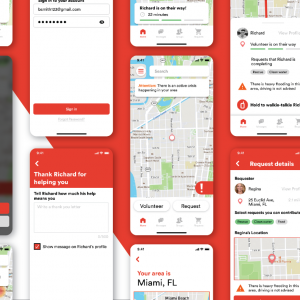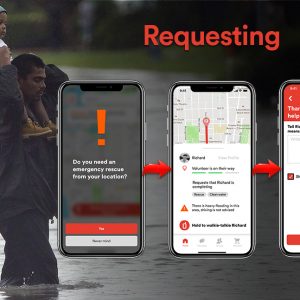Product Name: Communify
Topic/problem description: For the first time in human history, sea levels are on the rise. Our society has always been built upon the ocean; civilization thrives on the coasts. The human species needs the water for survival, for trade and commerce, and for pleasure. But our existence has had dire consequences and it is rapidly changing the oceans, causing them to warm, expand, and harvest bacteria in this unnatural process. It is threatening to devastate global coastal economic centers in ways that society has not yet faced. Unfortunately, rising tides do not discriminate who they affect; impoverished communities are confronting this harsh reality. It is well recorded that our climate is becoming exponentially more volatile. As Naomi Klein notes, there was a fivefold boost in natural disasters in the 2000s compared to that of the 1970s (2014). In unison with sea level rise, this put 2.4 billion peoples lives at stake, all of whom live less than 60 miles from the coast (United Nations, 2017). By 2050, miles and miles of shoreline in towns and cities around the world will be lost; millions upon millions of refugees will seek asylum due to the warming climate and the natural disasters that follow.
In the twenty-first century, we must realize that mitigation efforts around the world will not stop the natural disasters that are ravaging our societies. Instead, we must ask how communities can respond to these events and be resilient in the face of destruction. As industrial and interaction designers, our most vital role is to find the root of the problem and discover how we can design in the fight against nature’s will. The entirety of this issue grapples with people’s livelihoods as well as the future of our planet so we have to first identify the industry, individual, and natural outputs that are triggering sea level rise and remember that we are not geologists or hydrologists. The science is something that we certainly should be aware of but attempting to solve the root causes of the eroding coasts are outside the scope of our training. Instead, narrowing the scale of the problem is the best course of action.
Considering these factors, How might we implement tools and infrastructure that will facilitate community resilience to future natural disasters caused by the changing climate using service-based design?
Solution: Technology can connect people to their communities in extremely vital situations. For communities to be resilient, service designers can utilize digital communication in life saving ways. This is what Communify is designed to do at its core. I have designed Communify as my solution to empower individuals who are disadvantaged and have a platform to receive resources and rescue during the natural disasters that are recurring at an increasing rate. It also gives leaders in the community a platform to volunteer their time, resources, and skills to help those in need during these crises. Through each user’s personal profiles, as well as what services or resources they request, they are matched with someone who is best suited to safely complete the task.
While the service I have designed is certainly not the answer to the imminent dangers of climate change, it is a step to ensuring the long-term health and safety of communities and everyone within them. In the face of rising global temperatures, communities will be more prepared to deal with the consequences. If an elderly person is stuck in their home due to flooding caused by rising sea levels, they can seamlessly request a volunteer to rescue them and bring them to a safe location. If a family and their pets are trapped in their home with no air conditioning during a heat wave, they can find solace in knowing that there is a shelter that will protect them. Some may have the luxury of turning a blind eye to issues such as these, but for those who do not, this app can save their lives and keep communities thriving around the world.
References:
Klein, Naomi. This Changes Everything: Capitalism vs. the Climate. New York: Simon & Schuster, 2014.
“Factsheet: People and Oceans.” United Nations, June 5, 2017. https://www.un.org/sustainabledevelopment/wp-content/uploads/2017/05/Ocean-fact- sheet-package.pdf. (accessed Dec. 6, 2019).



